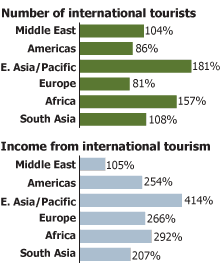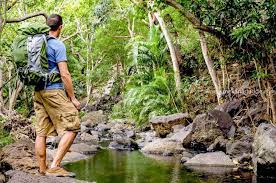Eco-tour
Courtesy : www.prb.org/
Eco-tourism has emerged as one of the most important sectors of the international tourism industry. The United Nations, recognizing eco-tourism’s potential role in sustainable development, has declared 2002 the “International Year of Eco-tourism.”
At its best, eco-tourism is responsible travel to natural areas that safeguards the integrity of the ecosystem and produces economic benefits for local communities that can encourage conservation. At the nexus of population and the environment, eco-tourism is a creative way of marrying the goals of ecological conservation and economic development.
Unfortunately, while some eco-tourism projects succeed in promoting both of these causes, others are less successful. Environmental deterioration and inequitable development may in some cases actually be exacerbated by eco-tourism. To ensure that eco-tourism fulfills its promise, policymakers, promoters, and participants should make sure that all tourism activities have minimal environmental impact, that such development is welcomed by local communities, and that it promotes stable and equitable economic development.
This fact sheet is designed to offer more insight into eco-tourism’s potential upside and downside as a development scheme.
A Booming Industry
- Rising numbers. The eco-tourism industry, which is growing rapidly, has emerged as one of the most important sectors of the international tourism industry, making up 7 percent of the world tourism market (see figure).1 In the Asia-Pacific region alone, eco-tour operators report growth rates of 10 percent to 25 percent a year.2 Demand for quality eco-tourism destinations will continue to grow as urban congestion, pollution, crowding, and concern for the natural environment all increase.
- More money. Many developing countries with established eco-tourism destinations have seen the number of eco-tourists, and the money they spend during their visits, dramatically increase over the last several years. In Costa Rica, the number of foreign tourists visiting national parks rose 330 percent in the six years between 1985 and 1991. Zimbabwe’s international tourist arrivals, dominated by eco-tourists, have increased threefold, while receipts from tourism quadrupled between 1985 and 1994. Direct economic contributions from park entrance fees in developing countries have been conservatively estimated to be between US$2 billion and US$12 billion annually. When indirect expenditures on such items as hotel rooms, rental cars, and food are included, eco-tourists spend between US$93 billion and US$233 billion annually in developing countries.3
- New investments. Many developing countries, boasting large, intact tropical ecosystems, pristine beaches, and archeological ruins, are eager to carve out a niche in this multibillion-dollar industry. Countries are investing in eco-tourism as a means of attracting foreign capital to propel economic development. Representatives of five Central American governments have formed a consortium, “Mundo Maya” (Mayan World), to promote visits to their cultural and natural attractions.
Rise in International Tourism, by Region
Percent Increase Between 1985 and 1998

Source: World Tourism Organization, “Facts and Figures”
(www.world-tourism.org/frameset/frame_market_data.htm).
A Boost to Conservation
- Self-financing protected areas. Revenue derived from park-entrance fees and similar sources can help finance the protection and management of environmentally sensitive areas. In Rwanda’s Parc des Volcans, tourists pay US$170 to spend one hour with lowland gorillas, generating US$1 million annually for the Rwandan government. This money is used to support the management and operation of all of Rwanda’s protected areas.4
- Wildlife pays so wildlife stays. Local communities, understanding the economic benefits of eco-tourism, are often motivated to protect resources and adopt conservationist attitudes. In Amboseli Park in Kenya, one much-publicized study estimated that each lion was worth US$27,000 and each elephant herd was worth US$610,000 in tourist revenue per year.5
- Driving sustainable development. Park authorities in Madagascar dole out 50 percent of park-entrance fees to local communities for sustainable development projects.6 In 1994, the wildlife tourism industry in Kenya employed over 55,000 people.7
- Long-term income. Eco-tourism often proves to be a more sustainable development strategy than extractive uses of the land such as logging, grazing, mining, or agriculture. In one economic assessment of rainforest land use in Bahia, Brazil, Conservation International determined that logging the forest provided an initial high return, followed by little income. Conversion of the forest into pastureland was even less profitable and required substantial initial investment. The study concluded that eco-tourism provided the most income over the long term.
- Environmental education. Local residents can benefit from the environmental education eco-tourism provides. Honduran schoolchildren from the capital city of Tegucigalpa are routinely taken to visit the La Tigra cloud forest visitor center, funded in part by eco-tourist dollars, to learn about the intricacies of the rainforest.
A Potential Threat to Local Communities and Ecosystems
- Destruction of ecosystems. High-volume tourism can damage the environment. Excessive entry into protected areas, especially when combined with high-impact activities such as hiking or camping, can be particularly harmful. Environmental stress can also arise from accommodating the needs of tourists: On Mexico’s Pacific coast, bright lights from beachfront hotels disorient female sea turtles coming ashore to lay eggs, often preventing successful reproduction.
- Population pressures. In the case of the Galapagos Islands, financially successful eco-tourism initiatives have drawn migrants into the area in search of work, putting additional strain on local infrastructure and the environment.
- Eco-exploitation? Eco-tourism revenues in less developed countries often leak back to industrialized countries, particularly when eco-tourism businesses are foreign-owned or when local products and labor are not utilized in eco-tourism operations. The World Bank estimated in 1988 that 55 percent of gross revenues for all tourism in the developing world eventually return to industrialized countries. Some more recent studies have put this figure as high as 90 percent for certain countries, including the Bahamas and Nepal.8 In the Annapurna region of Nepal, eco-tour operators are forced to import many foreign-made goods to support eco-tourists because of the inadequacy of local resources. As a result, only 10 percent of what trekkers spend there stays in the local economy.
- Locals pushed out. To develop sites for eco-tourism or create protected areas, governments must often resettle the indigenous inhabitants of a region. The systematic removal of Masai herdsmen from wildlife preserves by the Kenyan and Tanzanian governments provides a dramatic example of this kind of impact.
- Vulnerable industry. Economies that become dependent on eco-tourism may be destabilized by fluctuating demand. Much eco-tourism is seasonal in nature and depends on such factors as foreign currency exchange rates, weather, and political stability in host countries.
Making the Most of Eco-Tourism
Successful eco-tourism requires maximizing its environmental and economic benefits while minimizing ecological damage and disruption of local communities. To achieve these goals, eco-tourism development should be carefully planned from the beginning, keeping in mind these key points:
- Ensure sustainability. Limits on the number of tourists allowed in an area can help maintain the integrity and vitality of the site so that it can continue to draw tourists for years to come. Materials used in the construction of eco-tourism sites should be acquired in a sustainable manner. Renewable sources of energy such as solar, wind, or water, rather than polluting fossil fuels, are in many cases more practical, cost efficient, and less of a strain on local resources. Tourist facilities should be constructed on the outskirts of the park boundaries to minimize deleterious environmental impacts.
- Include local residents. Involving local people as consultants or directors of community-based, eco-tourism projects can help ensure community support. If they lack the necessary skills to participate in the eco-tourism industry or interact with foreign tourists, the government may provide job training and education.
- Maximize local economic benefits. Governments must take steps to ensure revenue retention by regulating foreign investment and by encouraging local investment and employment in lodging, guide services, and other ventures.
- Collaborate. Government officials and eco-tourism operators should seek assistance from conservation groups and nongovernmental organizations. Such groups can provide start up funding, training, and technical assistance that can lend both legitimacy and sustainability to a project.
Making Eco-Tourism Work in Peru
In the Tambopata Candamo Reserved Zone in southeastern Peru, Rainforest Expeditions, a for-profit eco-tourism company formed by Peruvian conservationists, has entered into a joint eco-tourism venture with the Ese’eja Indian community to attract tourists to a biologically rich site boasting macaws, giant river otters, and harpy eagles. The indigenous community provides labor, lodging, and food for the project, and in return receives 60 percent of the profits from the joint venture. Rainforest Expeditions requires a strong degree of local participation and gives the community equal decisionmaking power in the management of this unique endeavour.
Both Rainforest Expeditions and the Ese’eja community realize that the success of their tourism venture depends on the protection of local wildlife resources. Accordingly, both sides are actively involved in research, management, and conservation programs to protect the fragile ecosystem. Since its inception, the site has become a highly-rated eco-tourism destination, developed innovative natural and cultural education programs, and played an increasingly important role in the conservation and sustainable development of the region.




